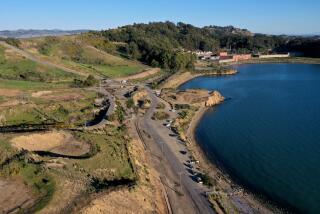Critter Rescue : Drive on to Save Small Animals When Ponds Go Dry
- Share via
When Redondo Beach empties two park ponds as part of a reconstruction project, John Oliver will make sure that a large population of marine life doesn’t go down the drain.
Oliver, Redondo Beach’s city clerk, and about 40 other users of Hopkins Wilderness Park plan to save the ponds’ critters by placing them in a large wading pool until workers have finished putting in new cement bottoms in the ponds.
“Instead of pulling the plug on them and killing them, we’re going to save them,” said Oliver, who is a member of the Friends of the Wilderness Park organization. “Our No. 1 concern is to save the animals. You hate to see anything like that die.”
Oliver was among scores of residents who were alarmed to learn that city officials had ordered 83 ducks and geese at Manhattan Beach’s Polliwog Park killed Sept. 7 as workers were rebuilding the pond.
The waterfowl had been removed from the pond in preparation for the improvements, and destroyed because city officials feared they carried disease.
Crayfish, mosquito fish, frogs, turtles, salamanders and even fresh-water shrimp are believed to inhabit the two ponds.
Oliver said they hope a company will donate a large wading pool or sell one for about $300.
“It’s got to be rigged up where we can keep people from terrorizing them,” Oliver said of the animals.
The 11-acre park at Knob Hill Avenue and Camino Real is valued by Redondo Beach officials for its camping and nature study facilities among trees, meadows, streams and ponds.
The federal government, which had used the site for the Nike missile radar-tracking system, gave Redondo Beach title to the area in 1971.
In 1975, the city planted about 1,000 trees, including eucalyptus, sycamore, gumwood, pine, ash, elm and California redwood.
Pumps were installed to feed water into two streams that flow into the ponds, which were built with a sand and porous clay bottom. Since then, mud has collected on the bottom and has blocked inlets. When the water is drained, the mud will be scraped out and workers will build concrete bottoms.
Oliver said the project, which was to have begun about two years ago, was delayed by budget problems. The animals were to have been transferred to another body of water.
Those plans were scrapped when it was found that many of the animals might be carrying spores from duckweed, a lime-green plant that spreads across the water surface. But officials feared that the duckweed would be spread throughout another body of water.
“It’s kind of a Catch-22,” Oliver said. “If you want to kill the weed, you have to kill the animal.”
So the organization has proposed putting the animals in the wading pool.
On the park’s largest pond, called Green Swamp, the duckweed has spread so much that signs were put up to warn visitors, especially children, not to try to walk in the water, said Bob Atkinson, the city’s director of parks and recreation.
At Manhattan Beach’s Polliwog Park, much of the marine life was lost recently when the city started work on a pond to improve its water quality.
“We have a real active community here,” Oliver said. “It’s too bad that they couldn’t get something going on it.”
More to Read
Sign up for Essential California
The most important California stories and recommendations in your inbox every morning.
You may occasionally receive promotional content from the Los Angeles Times.













